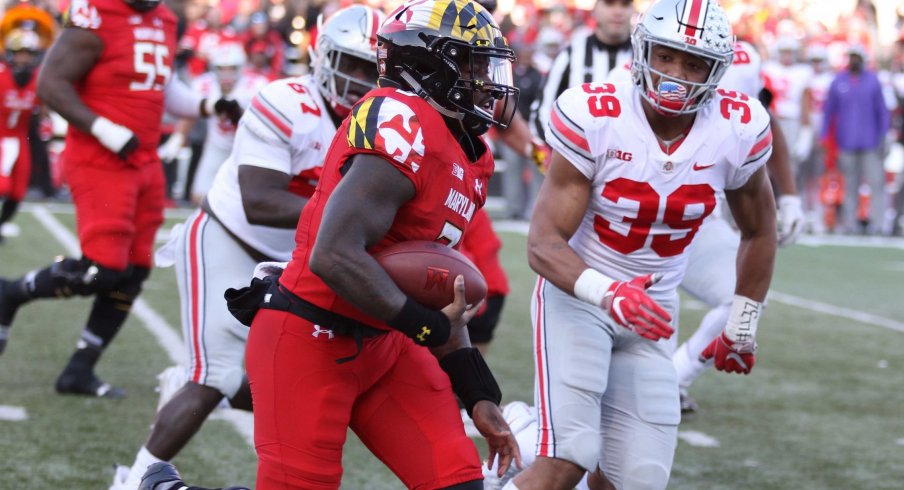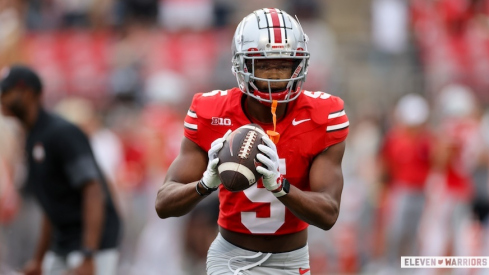“It just allows us to play fast, play free, play easy and just use our athleticism to play.” - Tuf Borland on the scheme employed by new coordinator Greg Mattison.
Throughout Spring practice, a common theme emerged whenever Buckeye defenders and coaches took the microphone inside the Woody Hayes Athletic Center - play simple & play fast. After three seasons with a former NFL head coach in charge of the Silver Bullets, this year's defense is changing up the way they play in hopes of meeting a championship standard once again.
In Greg Schiano's first two seasons in Columbus, his unit performed up to expectations, finishing in the top-10 nationally while averaging 300 yards-allowed or fewer. Last fall, however, the Buckeyes gave up an average of 403 yards-per-game, making them only the 71st-ranked defense in the land.
While Schiano lacked a first-round talent in the secondary for the first time in his tenure in 2018, the pass defense didn't lead to the drop-off in production from the unit as a whole. Rather, it was Ohio State's seeming inability to stop the run which doomed the defense.
After finishing 12th in the nation in 2016 by allowing an average of 3.35 yards-per-carry, Schiano's troops followed it up with an even better performance the following year, allowing just 2.94 ypc in 2017 which was good enough for fourth in the country. But by his third year in the conference, opponents seemed to have solved Schiano's rushing riddle, as the Buckeyes gave up a whopping 4.52 ypc and finishing 79th in the category nationally.
Though we've long maintained here at Film Study that Schiano's system was fairly straightforward, relying heavily on man-coverage with a lone, deep safety in the middle of the field, that doesn't mean it was easy to execute. With players focused on ensuring every potential receiver was covered, opposing offenses could easily manipulate the entire unit with simple motions and new formations, creating a domino effect of responsibility shifts that ultimately doomed the group as a whole.
It must be said, of course, that losing perhaps the best player in all of college football after only three games didn't help the cause either. For all the focus on Nick Bosa's pass-rushing ability, he was equally talented against the run and consistently made plays that covered up the mistakes of others.
With Bosa sidelined for the season midway through the TCU game, Schiano seemingly felt the need to mix up his fronts in the hopes of creating chaos and remaining unpredictable. One of his favorite methods to do so was by executing what's known as a "gap-exchange" in which two defenders do just that, trading responsibility for who covers the run gap over which they've lined up.
This maneuver became popular over the years as a method to counter the zone-read, with the defensive end crashing down on the handoff no matter what while a linebacker scraped over the top to play the quarterback outside on a keeper. This specific tactic is known as a "scrape-exchange," but it led to many defensive coaches employing the tactic throughout their systems as well.
But one of the pitfalls of employing man-coverage so often is that defenders must follow the receiver they're matched up with, allowing the offense to effectively define who is near the line of scrimmage and where. If the WILL linebacker is pulled away from the box as a result of motion (as we'll see below), that forces everyone to bump down a gap as a result.
If the defense had called for a gap-exchange on the play, then the middle linebacker is all of a sudden asked to be the edge defender instead of doing what probably comes most naturally to him, which is mirroring the back in hopes of making a tackle.
Not all the Buckeyes' failures against the run can be blamed on the scheme, though. As Schiano and linebacker coach Billy Davis looked to find the right personnel to fit their trio, a number of the big runs allowed can be attributed to simple failures in technique at the position.
As seen below, Minnesota may be in an unbalanced alignment with three linemen to the right of the center, but the Gophers called a simple, inside zone run. While the Buckeyes successfully execute a gap-exchange with Borland slicing inside to fill the B-gap, Justin Hilliard fails to fill the A-gap next to him, taking on a blocker head-on instead of trying to spill the blocker and keep his left arm free to make a play.
No single contest defined the unit's struggles against the run as did the penultimate regular-season matchup against a seemingly overmatched Maryland squad. After a difficult year on and off the field, the Terps were a two-touchdown underdog in their final home game.
But thanks to the game plan of offensive coordinator and interim head coach Matt Canada, the crowd of 38,000 in College Park was treated to a 52-51 shootout that saw Dwayne Haskins rewrite the Ohio State passing record books. However, they also saw the home team gallop for 339 yards on the ground at an average of 7.06 ypc.
Canada, as is his trademark, called for a constant variety of motions, trades, and unbalanced alignments, forcing the Buckeyes to think quickly on their feet and often end up out of position. Knowing Schiano wanted to keep linebackers matched up on tight ends in the passing game, Canada moved around his tight ends like chess pieces, pulling the superior Buckeye run defenders out of the box and forcing smaller defensive backs to fill gaps instead.
As the game wore on, the mistakes began to compound. The simple threat of a shift or motion seemed to send the Buckeyes back on their heels, creating chaos and leaving gaps unfilled throughout the unit.
“Last year, lot of changes with motions and stuff like that, which wasn't difficult, but sometimes it would be unsure, and sometimes we played that way, which made us play slower, which wasn't a bad thing, it was just a change-up," sophomore linebacker Dallas Gant said last month. "This year, just playing more straightforward, I would say.”
According to the new coordinator, Greg Mattison, the goal is to avoid those situations in which defenders can get caught thinking instead of playing.
"I've always been a believer that when you have talent up front, turn them loose. Let them go," Mattison said of his defensive line, specifically. "My feeling was, we're not going to have you going sideways running stunts and making up for other things, we're going to have you do your job and come forward."
One such way Mattison will do that is by marrying the secondary's coverage with his fronts in a more cohesive manner, allowing the unit to easily adapt to what they're seeing from an offense instead of bending the existing call to fit the scenario. Specifically, keeping linebackers in the box and letting the secondary rotate to the passing strength is a key first step in maintaining the integrity of the unit's structure, which we saw throughout last week's spring game.
“It's a lot more simple. It allows us to play ball faster. So I'm all for that," sophomore linebacker Teradja Mitchell responded when asked what Mattison's change in philosophy means for players like him. "A lot less reads allows you to just read the line, read the back, at the end play football, play football from that point on.”
"I don't look at what went wrong, or what people said went wrong with the defense when I came in here, that's not what I was about. I looked at the positives." Mattison added after a practice in early April. "Again, our thing will be to keep it simpler and let them play."



